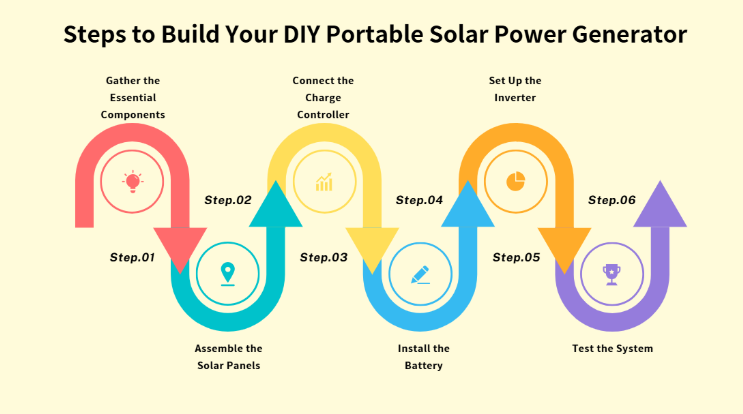How to Build a Portable Solar Power Generator

Are you interested in creating a reliable, eco-friendly power source that you can take just about anywhere? A DIY portable solar power generator is the solution. It may remind you of the time looking for backup power at home, a way to charge devices while camping, or a cleaner energy source for emergencies. Building your own solar generator with solar panels, a power station, and other gear can be a challenging but rewarding project. Not only does it allow you to harness the sun’s energy, but it also gives you control over the design and budget, making it ideal for those who want a customizable and cost-effective solution. But does a DIY portable solar power generator really save money?
In this guide, we’ll walk you through everything you need to know—from the basic components and estimated costs to step-by-step assembly instructions. By the end, you’ll have a fully functional solar generator that’s tailored to your needs. So, let’s get started on your journey to building a personal, portable source of solar power!
Why You Need a Portable Solar Power Generator for Outdoor Adventures
Before we jump into the building process, let’s take a moment to understand what a DIY solar generator is and why it’s beneficial to build your own. A DIY solar generator is a portable power system that uses solar panels to capture sunlight and convert it into electricity. This electricity is stored in a battery and can be used to power various devices and appliances. Building your own solar generator not only saves money but also allows you to customize your setup to match your specific power needs.
One of the primary benefits of a DIY solar generator is its sustainability. By using renewable energy from the sun, you reduce your reliance on fossil fuels, contributing to a cleaner environment. Additionally, having a portable power source is incredibly convenient for camping trips in the remote wilderness of Montana, a fishing trip to the backcountry lakes of Wyoming, or emergency situations when the grid is unavailable.
Steps to Build Your DIY Portable Solar Power Generator
Building your portable solar power generator is a rewarding and sustainable project. Follow these steps to create a functional and reliable power source that can be used for outdoor activities, emergencies, or as backup power for your home.
Step 1: Gather the Essential Components
To start, you’ll need to gather the core components required for your solar generator. These include:
- Solar Panels: These capture sunlight and convert it into electricity. Choose panels with the right wattage, efficiency, and durability to suit your needs.
- Battery and Battery Box: A deep-cycle battery stores the energy generated by the solar panels. A battery box protects the battery and makes it easy to transport.
- Inverter: Converts the direct current (DC) electricity from the battery into alternating current (AC) electricity, which powers household appliances.
- Charge Controller: Regulates the voltage and current from the solar panels to the battery, preventing overcharging and prolonging battery life.
- DC Input: Allows for alternative charging methods, such as connecting your solar generator to a car battery or another DC power source.
- Meter: Monitors the performance of your solar generator, including voltage output and battery charge levels.
- Casing: Provides protection for all components, shielding them from weather elements and ensuring easy transportation and installation.
Step 2: Assemble the Solar Panels
Once you have your solar panels, mount them securely in a location where they can get maximum exposure to sunlight. Ensure that the panels are wired correctly to harness energy effectively.
Step 3: Connect the Charge Controller
The charge controller is a crucial component that regulates the power going into your battery from the solar panels. Without it, the battery could overcharge and degrade quickly. Connect the controller to the solar panel and the battery according to the manufacturer’s guidelines.
Step 4: Install the Battery
Place the lithium-ion battery in a secure, ventilated space. Ensure that it is properly connected to both the charge controller and the inverter. This will allow it to store energy from the solar panels and release it as needed.
Step 5: Set Up the Inverter
The inverter will convert the stored DC energy in the battery to AC, which powers your electrical devices. Connect the inverter to the battery, ensuring it has enough capacity to handle the devices you plan to use. You can now plug in any AC-powered appliances or gadgets into the inverter’s outlets.
Step 6: Test the System
Before using your DIY portable solar power generator, test the system to ensure everything is operating correctly. Monitor the charge controller to ensure the battery is being charged properly, and check the inverter to confirm that it’s delivering AC power smoothly.
By following these steps, you will have a fully functional DIY portable solar generator that can provide you with clean, renewable energy wherever you need it.
Buying vs. Building: Cost Comparison
When deciding between buying a portable solar power generator or building one yourself, cost and convenience are two key factors to consider. While building your DIY solar generator can be a fulfilling project, it’s essential to weigh the pros and cons, especially in terms of cost, time, and practicality.
Building a DIY Solar Generator: Initial Investment & Labor
Building a DIY portable solar power generator can be cost-effective if you already possess some of the required components or can find them at discounted prices. Here’s a rough breakdown of the costs involved:
- Solar Panels: $100 to $300 per panel, depending on wattage and efficiency.
- Lithium-Ion Battery: $500 to $1,500, depending on capacity and brand.
- Inverter: $200 to $1,000, depending on power capacity.
- Charge Controller: $50 to $300, depending on the system’s needs.
- Wiring & Miscellaneous Supplies: $100 to $300.
The total cost of building a DIY solar generator could range from $1,000 to over $3,000, depending on the size of the system and the quality of the components you choose.
On top of that, it will require substantial time and effort to gather all the parts, assemble them, and ensure that everything works properly. Frankly speaking, DIY hobbyists should consider:
- Skills Required: Basic electrical knowledge and some DIY skills are needed to safely and effectively assemble a solar generator. Familiarity with tools and electrical wiring is a plus.
- Time Commitment: Depending on your experience level, assembling a DIY solar generator can take anywhere from a few hours to several days. This includes planning, purchasing components, and the actual assembly.
- Potential Challenges: Troubleshooting configuration issues, ensuring compatibility between components, and safely connecting electrical systems can be challenging for beginners.
Purchasing a Ready-Made Solar Generator: Convenience & Value
On the other hand, buying a pre-assembled portable solar power generator like the Jackery Solar Generator 1000 V2 eliminates the hassle of DIY assembly. The pre-assembled solar generator is an all-in-one solution, combining solar panels, a powerful battery, and an efficient inverter, all pre-configured and ready for use.
Here are a few benefits of purchasing a ready-made solar generator:
- Plug-and-Play Design: Pre-assembled units come ready to use out of the box, saving you the time and effort of installation.
- Durability and Quality Assurance: A branded system like Jackery Solar Generator 1000 V2 undergoes rigorous testing to ensure it can withstand various weather conditions and perform efficiently over time.
- Portability: Unlike many DIY systems, pre-built generators are designed with portability in mind, featuring compact and lightweight designs that are easy to transport.
- Warranty and Support: Pre-made units often come with warranties and customer support, providing peace of mind if something goes wrong.
The Jackery Solar Generator 1000 V2 retails around $1,299, making it a cost-effective and practical alternative to building your own. When you factor in the cost of individual components and the time required for assembly, purchasing a ready-made generator like Jackery’s product often ends up being the more economical and reliable option in the long run.
More Advantages of Jackery Solar Generator 1000 V2
The Jackery Solar Generator 1000 v2 offers distinct advantages over a DIY solar generator, making it a compelling choice for those seeking reliability and convenience without the hassle of assembly. One of its standout features is the impressive 1070Wh capacity paired with a robust 1500W output, ensuring that you have ample power to run various devices, whether during a camping trip or a home emergency.
This power station shines with its lightweight and portable design, weighing just 24.2 pounds, making it easier to transport and store compared to the often-bulkier DIY setups. Its compact nature, combined with a foldable handle, ensures that you can conveniently bring power wherever you go.
The Jackery Solar Generator 1000 v2 also boasts fast charging capabilities, including an emergency supercharging feature that can power up from 0 to 100% in just one hour. This rapid charging is complemented by the advanced ChargeShield 2.0 technology, offering 62 forms of all-around protection, ensuring both safety and efficiency in operation.
Moreover, the convenience of having a pre-assembled unit cannot be overstated. It comes ready to use, eliminating the time and effort required to source and assemble individual components in a DIY project. This ease of use is coupled with a comprehensive 3-year warranty and an additional 2-year extended warranty, providing peace of mind and support that is often lacking with DIY solutions.
In essence, the Jackery Solar Generator 1000 v2 combines powerful performance with user-friendly operation, making it an ideal choice for those who prioritize time-saving, reliability, and peace of mind over the labor-intensive process of building a DIY solar generator.
Conclusion
Whether you’re a camping enthusiast, someone who enjoys road trips, or simply looking to safeguard your home during power outages, a portable solar power generator is an invaluable tool. While building your own DIY solar generator may seem like a cost-effective option, the convenience, durability, and reliability offered by a product like the Jackery Solar Generator 1000 V2 make it a worthwhile investment.
Jackery, a leader in portable solar solutions, has designed the Jackery Solar Generator 1000 V2 to meet a variety of power needs, offering a sustainable and user-friendly alternative to traditional fuel-powered generators. With its portable design, impressive power capacity, and solar charging capabilities, this generator ensures you’re ready for any outdoor adventure or unexpected power outage.
For those seeking a reliable, high-performing portable solar power generator, Jackery provides a complete solution that eliminates the complexities of DIY builds while offering superior performance and ease of use. Investing in the Jackery Solar Generator 1000 V2 means being prepared for the future—whether it’s for your next camping trip or ensuring your household stays powered during emergencies.







